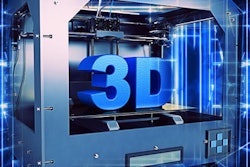
Do provisional restorations designed with CAD/CAM technology and output using 3D printing hold up in a patient's mouth, or should you stick with conventionally cured provisional materials?
Researchers from Oregon tested a 3D-printed material against two provisional materials and found it to have sufficient mechanical properties to allow it to be used intraorally. Their results were published online in Dental Materials (October 27, 2017).
"Our results suggest that a 3D-printable provisional restorative material allows for sufficient mechanical properties for intraoral use, despite the limited 3D printing accuracy of the printing system of choice," the study authors wrote.
The lead study author was Anthony Tahayeri, a research assistant in the division of biomaterials and biomechanics in the department of restorative dentistry at the Oregon Health & Science University School of Dentistry in Portland.
Comparable range
The advent of CAD/CAM imaging and milling systems has created a new modality of clinical dentistry, especially in restorative dentistry. But there isn't much literature that focuses on which characteristics and properties of 3D-printed restorative dental materials are usable in a patient's mouth.
The researchers of the current study wanted to see if a commercially available 3D-printable dental material currently marketed for provisional restorations (NextDent C&B, NextDent) and printed using a relatively low-cost, commercially available stereolithography 3D printer could be used intraorally by comparing it to two conventionally cured provisional materials. They wanted to find out if new 3D-printed polymers have properties that are in the same range as commercial products that are currently used successfully.
The researchers 3D printed 25 x 2 x 2-mm samples using the FormLabs 1+ stereolithography 3D printer (FormLabs) at four different printing angles: 0°, 15°, 45°, and 90°. The printed samples were compared to those for two conventionally cured provisional materials: Integrity Temporary C&B material (Dentsply Sirona) and Jet (Lang Dental).
“The 3D-printed provisional restorations would have sufficient mechanical properties to be used intraorally.”
The accuracy of samples was directly correlated with the printing orientation, the researchers reported, with those printed at a 90° orientation having the lowest average printing error followed by those printed at 0°, 15°, and 45°. The lowest average error for the 90° orientation was significantly lower than the 45° orientation (p < 0.05), the authors noted.
They reported no direct correlation between printing layer thickness and elastic modulus, which is the amount of force it takes to deform a material, or peak stress.
Next, the researchers compared the 3D-printed samples to the provisional materials. They found that the 3D samples had a modulus comparable to the Jet samples, but they had a significantly lower modulus than the Integrity samples.
When comparing peak stress, the group found that the 3D-printed samples and the Integrity material had comparable results. The 3D-printed samples had a higher peak stress than the Jet samples. The degree of conversion of the 3D-printed samples also appeared higher than that of Integrity or Jet. This is important, because the lower the degree of conversion, the more likely a material will have inferior mechanical properties, greater discoloration, and greater degradation, according to the authors.
"This suggests that both the elastic modulus and peak stress of the 3D-printed material were in a comparable range to those of Integrity and Jet, which indicates that the 3D-printed provisional restorations would have sufficient mechanical properties to be used intraorally," they wrote.
Mechanical properties
The authors noted an important limitation to their study was that the 3D-printed materials were not examined under multidirectional loading. A crown will have to survive under stresses that are not strictly uniaxial, they explained.
However, the authors concluded that, within study limits, these 3D-printed materials could be used intraorally, but they added that there is much study needed to improve the accuracy of these materials.
"Future work utilizing 3D-printing systems that allow for optimization of printing parameters as a function of resin of choice should be performed to improve the accuracy of 3D-printed dental materials," they wrote.


















